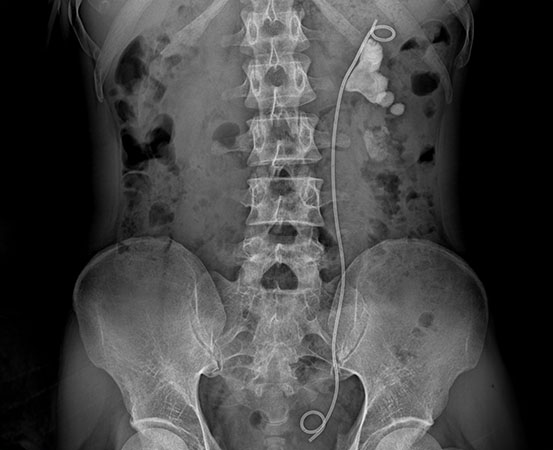
A recurrent fever that started by the end of 2022 continued for seven months until Pooja DP, 25, a homemaker from Mandya, Karnataka underwent an ultrasound scan, revealing stones in her ureter. As advised by the doctors she underwent a procedure for placement of a ureteral stent, known as a kidney stent for the kidney stones to drain out.
In May 2023, she underwent a laser lithotripsy procedure, through which stones from the kidney, bladder, urethra, and ureters are removed by breaking them down into tiny fragments. She was put on a ureteral stent for a month and a half. Speaking to Happiest Health, Pooja said, “I had no abdominal pain or discomfort. As I had a recurrent fever, we carried out multiple tests which showed that I had an infection. After the ultrasound scan, I was informed that I had a 1 cm stone that was stuck in the left ureter causing infection.”
What is a kidney stent?
Stent is a soft, hollow, thin tube placed inside the ureter. The tube connects kidneys to the bladder for urine flow so as to allow the kidney stones to drain out or when an infection is present affecting the kidneys to work adequately. “The stent is placed through a procedure from the bladder to the kidney through the ureter tunnel. The stent is also referred to as JJ stent due to its shape,” says Dr Sanjeev Kumar Hiremath, chief nephrologist, Sagar Hospitals, Bengaluru.

Ureter stent is a safety mechanism used to ensure that the tube isn’t blocked and doesn’t affect the urine flow from the kidney, says Dr D Venkat Subramaniam, executive director and senior consultant urologist, Asian Institute of Nephrology and Urology, Chennai. “Whenever a stone is stuck in the ureter for a long time, it damages the tube causing edema (inflammation of the ureter) which can cause pain and infection. The stent is placed in either one or both the ureters depending on whether one kidney is affected or both,” he said.
What are kidney stents used for?
It’s commonly used for treating kidney stones, but apart from that, it’s used for any urological endoscopic procedure or reconstructive surgery involving the urinary tract, says Dr Subramaniam. “Stents are placed in case of severe kidney infection which isn’t responding to antibiotics. In some advanced cancers, they can cause compression on the kidneys from outside resulting in kidney failure. When the tube is blocked, the creatinine will be high and people with cancers cannot undergo chemotherapy. This is when stents help in improving kidney function,” he said.
Made of silicon or plastic, adult kidney stents are between 24cm and 26cm in length and 1mm-2mm in diameter. Pediatric stents are 15cm to 20cm in length. There are two types of stents – short-term and long-term stents. “In cases of kidney stones, blood clots, and severe infections, the stents are placed for a temporary period of four to six weeks. While in cases of chemotherapy, they require it for a longer period of 6 months or more than a year,” said Dr Hiremath.
In 90% of cases, the stent is placed through a cystoscopy procedure where the stent is placed in the retrograde setting (backward), says Dr Subramaniam. “The person will be put on anesthesia and the device is inserted from the urinary passage to the kidneys. In very few cases where the surgery is performed on the kidney, the stents are placed in an antegrade setting where the stent is placed from the kidney to the bladder,” he explained.
How does it feel?
Most of them don’t feel the presence of the stent inside their body, says Dr Hiremath. “First one or two days after insertion of the stent, they may feel slight discomfort as the tip of the stent is placed in the bladder causing irritation and may have the urge to pass urine. They may also notice blood in the urine, but it stops after 48 hours,” he said.
Pooja was admitted to the hospital for a day and felt a burning sensation while passing urine for up to 10 days. “There was slight pain which disappeared after 10 days and I couldn’t feel its presence inside,” she said.
Kidney stent removal
The stent is removed in the same cystoscopy procedure and the person won’t have any irritation after that, says Dr Subramaniam. “Once the person has recovered and there’s no inflammation or infection, the stent is removed. The temporary stents must be removed at the stipulated time and leaving them longer will cause harm. The short-term stents are made of a different material which won’t last for longer than six months and are removed within that period,” he said.
Takeaways
- Kidney stents are mostly placed through a cystoscopy procedure where it is inserted from the urinary passage. It travels from the bladder to the kidney.
- In some cases where the surgery is performed on the kidney, the stents are placed from the kidney to the bladder.
- It is placed in the ureter tube to prevent inflammation of the ureter and is mostly used in kidney stones.
- Kidney or Ureter stents are also known as JJ stents due to their shape.

















